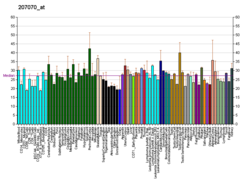Retinal G protein coupled receptor
RPE-retinal G protein-coupled receptor also known as RGR-opsin is a protein that in humans is encoded by the RGR gene.[5][6] RGR-opsin is a member of the rhodopsin-like receptor subfamily of GPCR. Like other opsins which bind retinaldehyde, it contains a conserved lysine residue in the seventh transmembrane domain.[7][8] RGR-opsin comes in different isoforms produced by alternative splicing.[6]
Function[]
RGR-opsin preferentially binds all-trans-retinal,[8] which is the dominant form in the dark adapted retina, upon light exposure it is isomerized to 11-cis-retinal.[9] Therefore, RGR-opsin presumably acts as a photoisomerase to convert all-trans-retinal to 11-cis-retinal, similar to in invertebrates. 11-cis-retinal is isomerized back within rhodopsin and the iodopsins in the rods and cones of the retina. RGR-opsin is exclusively expressed in tissue close to the rods and cones, the retinal pigment epithelium (RPE) and Müller cells.[7]
Clinical significance[]
RGR-opsin may be associated with autosomal recessive and autosomal dominant retinitis pigmentosa (arRP and adRP, respectively).[10][6]
Interactions[]
RGR-opsin has been shown to interact with KIAA1279.[11]
References[]
- ^ a b c GRCh38: Ensembl release 89: ENSG00000148604 - Ensembl, May 2017
- ^ a b c GRCm38: Ensembl release 89: ENSMUSG00000021804 - Ensembl, May 2017
- ^ "Human PubMed Reference:". National Center for Biotechnology Information, U.S. National Library of Medicine.
- ^ "Mouse PubMed Reference:". National Center for Biotechnology Information, U.S. National Library of Medicine.
- ^ Chen XN, Korenberg JR, Jiang M, Shen D, Fong HK (Jun 1996). "Localization of the human RGR opsin gene to chromosome 10q23". Human Genetics. 97 (6): 720–2. doi:10.1007/BF02346179. PMID 8641686. S2CID 6086858.
- ^ a b c "Entrez Gene: RGR retinal G protein coupled receptor".
- ^ a b Jiang M, Pandey S, Fong HK (Dec 1993). "An opsin homologue in the retina and pigment epithelium". Investigative Ophthalmology & Visual Science. 34 (13): 3669–78. PMID 8258527.
- ^ a b Shen D, Jiang M, Hao W, Tao L, Salazar M, Fong HK (Nov 1994). "A human opsin-related gene that encodes a retinaldehyde-binding protein". Biochemistry. 33 (44): 13117–25. doi:10.1021/bi00248a022. PMID 7947717.
- ^ Hao, W; Fong, HK (5 March 1999). "The endogenous chromophore of retinal G protein-coupled receptor opsin from the pigment epithelium". The Journal of Biological Chemistry. 274 (10): 6085–90. doi:10.1074/jbc.274.10.6085. PMID 10037690.
- ^ Morimura H, Saindelle-Ribeaudeau F, Berson EL, Dryja TP (Dec 1999). "Mutations in RGR, encoding a light-sensitive opsin homologue, in patients with retinitis pigmentosa". Nature Genetics. 23 (4): 393–4. doi:10.1038/70496. PMID 10581022. S2CID 35176366.
- ^ Rual JF, Venkatesan K, Hao T, Hirozane-Kishikawa T, Dricot A, Li N, Berriz GF, Gibbons FD, Dreze M, Ayivi-Guedehoussou N, Klitgord N, Simon C, Boxem M, Milstein S, Rosenberg J, Goldberg DS, Zhang LV, Wong SL, Franklin G, Li S, Albala JS, Lim J, Fraughton C, Llamosas E, Cevik S, Bex C, Lamesch P, Sikorski RS, Vandenhaute J, Zoghbi HY, Smolyar A, Bosak S, Sequerra R, Doucette-Stamm L, Cusick ME, Hill DE, Roth FP, Vidal M (Oct 2005). "Towards a proteome-scale map of the human protein-protein interaction network". Nature. 437 (7062): 1173–8. doi:10.1038/nature04209. PMID 16189514. S2CID 4427026.
Further reading[]
- Jiang M, Shen D, Tao L, Pandey S, Heller K, Fong HK (Apr 1995). "Alternative splicing in human retinal mRNA transcripts of an opsin-related protein". Experimental Eye Research. 60 (4): 401–6. doi:10.1016/S0014-4835(05)80096-X. PMID 7789419.
- Shen D, Jiang M, Hao W, Tao L, Salazar M, Fong HK (Nov 1994). "A human opsin-related gene that encodes a retinaldehyde-binding protein". Biochemistry. 33 (44): 13117–25. doi:10.1021/bi00248a022. PMID 7947717.
- Chen P, Lee TD, Fong HK (Jun 2001). "Interaction of 11-cis-retinol dehydrogenase with the chromophore of retinal g protein-coupled receptor opsin". The Journal of Biological Chemistry. 276 (24): 21098–104. doi:10.1074/jbc.M010441200. PMID 11274198.
- Yang M, Fong HK (Feb 2002). "Synthesis of the all-trans-retinal chromophore of retinal G protein-coupled receptor opsin in cultured pigment epithelial cells". The Journal of Biological Chemistry. 277 (5): 3318–24. doi:10.1074/jbc.M108946200. PMID 11723126.
- Bellingham J, Wells DJ, Foster RG (Jan 2003). "In silico characterisation and chromosomal localisation of human RRH (peropsin)--implications for opsin evolution". BMC Genomics. 4 (1): 3. doi:10.1186/1471-2164-4-3. PMC 149353. PMID 12542842.
- Tarttelin EE, Bellingham J, Bibb LC, Foster RG, Hankins MW, Gregory-Evans K, Gregory-Evans CY, Wells DJ, Lucas RJ (Mar 2003). "Expression of opsin genes early in ocular development of humans and mice". Experimental Eye Research. 76 (3): 393–6. doi:10.1016/S0014-4835(02)00300-7. PMID 12573668.
- Bernal S, Calaf M, Garcia-Hoyos M, Garcia-Sandoval B, Rosell J, Adan A, Ayuso C, Baiget M (Jul 2003). "Study of the involvement of the RGR, CRPB1, and CRB1 genes in the pathogenesis of autosomal recessive retinitis pigmentosa". Journal of Medical Genetics. 40 (7): 89e–89. doi:10.1136/jmg.40.7.e89. PMC 1735523. PMID 12843338.
- Zhu L, Imanishi Y, Filipek S, Alekseev A, Jastrzebska B, Sun W, Saperstein DA, Palczewski K (Aug 2006). "Autosomal recessive retinitis pigmentosa and E150K mutation in the opsin gene". The Journal of Biological Chemistry. 281 (31): 22289–98. doi:10.1074/jbc.M602664200. PMC 1618956. PMID 16737970.
- Lin MY, Kochounian H, Moore RE, Lee TD, Rao N, Fong HK (2007). "Deposition of exon-skipping splice isoform of human retinal G protein-coupled receptor from retinal pigment epithelium into Bruch's membrane". Molecular Vision. 13: 1203–14. PMID 17679941.
This article incorporates text from the United States National Library of Medicine, which is in the public domain.
- Genes on human chromosome 10
- G protein-coupled receptors
- Transmembrane receptor stubs




